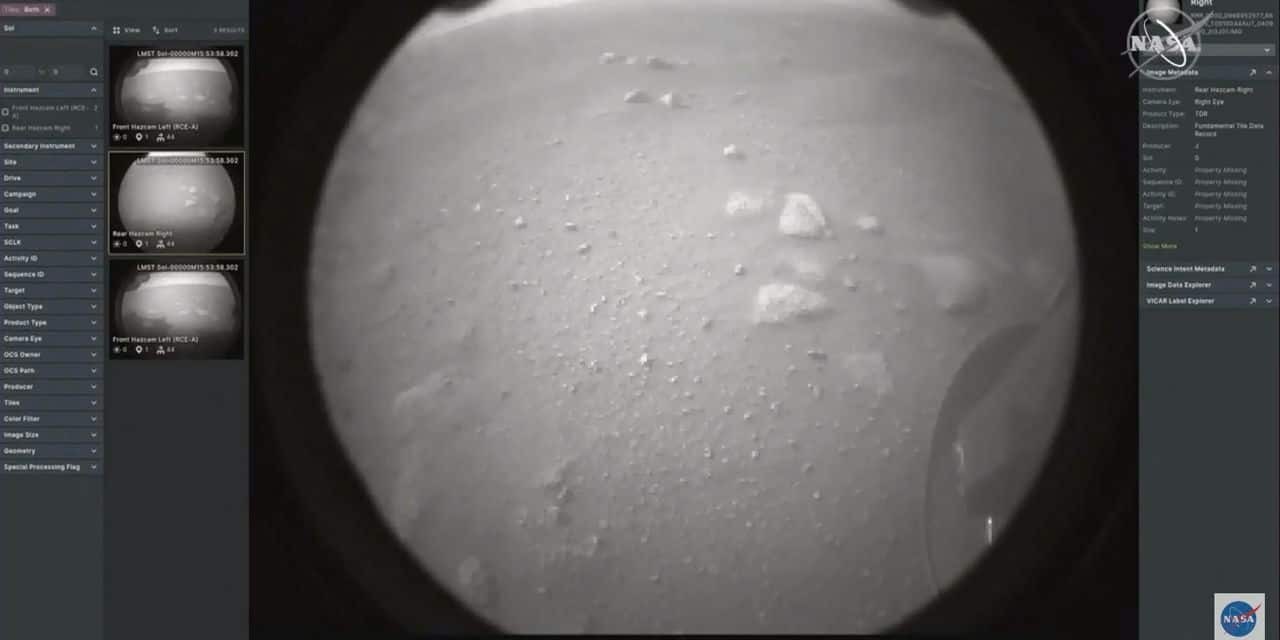The Perseverance robot has arrived on Mars, the quest for ancient life can begin
“Landing confirmed!” Exclaimed Swati Mohan, in charge of operations control at the Jet Propulsion Laboratory, in Pasadena, California, quickly filled with cries of joy from the teams present in the control room.
NASA immediately released a photo taken by the rover there. “Hello world. My first sight of the house that will be mine forever,” tweeted the rover’s official account to accompany the extraordinary black and white image, on which we can see the shadow of the vehicle projected on the ground .
The maneuver was ultra-perilous and the landing site, the crater of Jezero, the most risky ever attempted, because of its relief.
After entering the Martian atmosphere at 20,000 km / h, friction with the air raised the temperature of the ship to 1,300 ° C. The rover was protected by a heat shield, which was only released after the opening of a huge supersonic parachute.
Eight retro-rockets finished slowing him down before he deployed his six wheels, suspended along cables until contact with the ground.
For the first time, the US space agency’s “Mars 2020” mission has the explicit goal of finding traces of ancient life on the red planet, by collecting up to thirty rock samples over several years.
The sealed tubes will then have to be brought back to Earth by a future mission, in the 2030s, in order to be analyzed and perhaps finally be able to answer “one of the questions that have inhabited us for centuries, namely: are we are we alone in the universe? “said Thomas Zurbuchen, associate administrator for science at NASA.
Perseverance is the largest and most complex vehicle ever to be sent to Mars. It weighs a ton and is equipped with a robotic arm of more than two meters.
Proof that the mission is also the result of international cooperation: French President Emmanuel Macron, whose country designed one of the rover’s many scientific instruments, attended the landing at the Paris headquarters of the National Studies Center space (Cnes).
Exceptional discovery
Researchers believe that Jezero crater was home to a deep lake about 50 km wide 3.5 billion years ago.
“We have very strong evidence that Mars could have harbored life in the distant past,” Ken Williford, deputy head of the mission, told a press conference on Wednesday. “The question is: is (life on) Earth an anomaly, a stroke of luck?”
The first samples should start this summer. Several routes are planned to dig in different environments, including the shore of the old lake, and the delta formed by a river that flowed into it.
Scientists are looking for what they call biosignatures: traces of microbial life that “can take all kinds of forms,” such as “chemicals” or “environmental changes,” explained Mary Voytek, program director. astrobiology for NASA. “We astrobiologists have dreamed of this mission for decades,” she said enthusiastically.
“Either we find life, and that would be an exceptional find, or we don’t, (…) and it will suggest that not all habitable environments are inhabited,” warned Ken Farley, scientific project. And that we will have to look elsewhere.
The 450 or so team members who will pilot this phase will also work in exceptional conditions because of the Covid-19 pandemic, he stressed: “The mission will be carried out from the people’s lounge, all over the place. of the globe. “
Helicopter and oxygen machine
However, the first months of the mission will not be devoted to this first objective. Parallel experiments are planned.
NASA wants in particular to prove that it is possible to fly a motorized vehicle on another planet. A helicopter, baptized Ingenuity, will have to be able to rise in air with a density equivalent to 1% of that of the Earth’s atmosphere.
Two microphones could also, for the first time, record Martian sound.
NASA will also experience the production of oxygen directly on site, using an instrument the size of a car battery that functions much like a plant, by sucking carbon dioxide from the Martian atmosphere.
This oxygen could be used by future human settlers to breathe, but also as fuel.
Since the first rover to set foot on Martian soil in 1997, all are American, and one of them, Curiosity, is still in operation.
But China recently placed its “Tianwen-1” probe into orbit around Mars, containing an unmanned robot that is expected to attempt to land around May.
